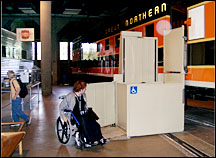The Principles of Universal Design
Principle 3: Simple and Intuitive
Definition
Simple and Intuitive design advocates that the use of the design should be easy to understand, regardless of the users' experience, knowledge, language skills, or concentration level.
 Example
Example
An elevator is an example of a design that is simple and intuitive.
Conversely, a lift is not always familiar to users. This may cause potential confusion, or a lack of comfort with using the device. As a result, individuals may choose to avoid using it. In the end, individuals may miss the experience.
Example
The handheld captioning system at Walt Disney World, shown on the right, provides captioning for the moving amusement rides. Designed for wireless reception, this device does not require the use of extra control features and provides a simple solution for park visitors.
Guidelines
- Eliminate unnecessary complexity.
- Be consistent with user expectations and intuition.
- Accommodate a wide range of literacy and language skills.
- Arrange information consistent with its importance.
- Provide effective prompting and feedback during and after task completion.

